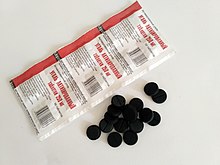医用活性碳
医用活性炭(英语:Activated charcoal (medication),也可写为activated carbon),是一种用于治疗经由口服有毒物质而避免中毒的药物。[1]为能达到治疗效果,必须在事件发生后甚短的时间内(通常是一个小时)施用。[1][2]但此种疗法不适用于由氰化物、腐蚀剂、铁质、锂、酒精或马拉松 (农药) 引发的中毒。[2]它以口服或是透过鼻胃管给药。[3]也可置于血液灌流机内达到过滤毒素的作用。[1]
 Activated charcoal for medical use | |
| 临床资料 | |
|---|---|
| 商品名 | CharcoAid及其他 |
| AHFS/Drugs.com | Monograph |
| 给药途径 | 口服给药或鼻胃管给药 |
| 识别信息 | |
| CAS号 | 7440-44-0 |
| ChemSpider |
|
| UNII | |
| CompTox Dashboard (EPA) | |
| ECHA InfoCard | 100.036.697 |
摄取此种活性碳常见的副作用有呕吐、黑便、腹泻和便秘。[1]如果不慎将其吸入肺部,可能会导致严重的副作用 - 非感染性肺炎。[1][2]在脱水的患者身上可能会发生消化道阻塞。[1]在个体怀孕期间摄取对于胎儿,或是个体在母乳哺育期间使用对于婴儿通常无安全上顾虑。[3]活性碳透过吸附毒素以发挥作用。[1]
虽然自古以来木炭就被用来处理口服物质而中毒的案例,而活性碳自1900年代起才被使用。[4][5]活性碳已被列入世界卫生组织基本药物标准清单之中。[6]
医疗用途
编辑口服物质中毒
编辑活性碳用于治疗多种口服物质(例如苯巴比妥和卡马西平)而中毒的案例,[7]但对其中多种(包括强酸或强碱、铁、锂、砷、甲醇、乙醇或是乙二醇)的中毒并无疗效。[7]
活性碳是最常用来清除中毒者消化道中的药剂,但医疗专业人员在决定是否需用此药物时会谨慎从事。[7]有一项针对接触农用杀虫剂和黄花夹竹桃急性中毒的研究,发现施用活性碳无法提升存活率。[8]
消化道相关问题
编辑英国从19世纪初开始即有木炭饼干问世,最初用作治疗胀气和胃病之用。[9]
活性碳锭剂或胶囊在许多国家被用来治疗腹泻、消化不良和胀气,是非处方药。[10]有一些证据显示它可为接受爱莱诺迪肯治疗的癌症患者作预防腹泻之用。[11]但使用活性碳会干扰人体对某些药物的吸收,且会导致一些检查(如粪便潜血检查)读数变得不可靠。[12]个体在进行腹部超音波检查之前服用活性碳可减少肠道气体含量,而得到更为清晰的影像。[13]
其他用途
编辑声称活性碳可美白牙齿、治疗酒精引起的宿醉和防止腹胀等作用的说法并无证据支持。[14][15]号称规律性摄取活性碳可达到解毒的效果也缺乏证据,被认为是伪科学。[16]
副作用
编辑作用机转
编辑如果个体疑似口服药物中毒,医护人员会在现场或医院急诊室施用活性碳。在极少数情况下,它也可用于血液灌流系统,以清除患者血液中的毒素。活性碳已成为许多中毒案例的首选治疗法,而其他净化方法(例如利用吐根酊引发呕吐或是洗胃)已很少使用。[18]
历史
编辑木炭作医疗使用可追溯到公元前1500年的古埃及时期,被用来中和伤口发出的臭味。到公元前400年,腓尼基人在海上航行时,将水盛在内壁烧焦的木桶中,以改善船上储水的味道,此显示当时人们已了解木炭有吸附不良化学物质的能力。目前形式的活性碳是在18世纪所开发,首先于精炼糖过程中使用,将原糖中的有色杂质去除。[21]活性碳用于医疗用途始于19世纪初。曾有一项于1835年进行的著名实验,证明活性炭的吸附毒素能力,研究人员于实验中将剧毒的番木鳖碱与活性炭混合后喂食动物,结果那些动物并未显示有中毒情况。[22]
参见
编辑- ^ 1.0 1.1 1.2 1.3 1.4 1.5 1.6 Charcoal, Activated. The American Society of Health-System Pharmacists. [2016-12-08]. (原始内容存档于2016-12-21).
- ^ 2.0 2.1 2.2 World Health Organization. Stuart MC, Kouimtzi M, Hill SR , 编. WHO Model Formulary 2008. World Health Organization. 2009: 57. ISBN 9789241547659. hdl:10665/44053 .
- ^ 3.0 3.1 Hamilton R. Tarascon Pocket Pharmacopoeia 2015 Deluxe Lab-Coat Edition. Jones & Bartlett Learning. 2015: 469. ISBN 9781284057560.
- ^ Cecen F, Aktas Ö. 1. Activated Carbon for Water and Wastewater Treatment: Integration of Adsorption and Biological Treatment. John Wiley & Sons. 2011-09-19. ISBN 9783527639458. (原始内容存档于2016-12-20) (英语).
- ^ Tascón JM. Novel Carbon Adsorbents. Elsevier. 2012: 640. ISBN 9780080977447. (原始内容存档于2016-12-20) (英语).
- ^ World Health Organization. World Health Organization model list of essential medicines: 21st list 2019. Geneva: World Health Organization. 2019. hdl:10665/325771 . WHO/MVP/EMP/IAU/2019.06. License: CC BY-NC-SA 3.0 IGO.
- ^ 7.0 7.1 7.2 Charcoal, Activated. The American Society of Health-System Pharmacists. [2014-04-23]. (原始内容存档于2014-05-22).
- ^ Eddleston M, Juszczak E, Buckley NA, Senarathna L, Mohamed F, Dissanayake W, et al. Multiple-dose activated charcoal in acute self-poisoning: a randomised controlled trial. Lancet. February 2008, 371 (9612): 579–587. PMC 2430417 . PMID 18280328. doi:10.1016/S0140-6736(08)60270-6.
- ^ Rolland JL. The Food Encyclopedia: Over 8,000 Ingredients, Tools, Techniques and People. Robert Rose. 2006: 148. ISBN 0-7788-0150-0.
- ^ Stearn M. Warts and all: straight talking advice on life's embarrassing problems. London: Murdoch Books. 2007: 333 [2009-05-03]. ISBN 978-1-921259-84-5. (原始内容存档于2017-09-10).
- ^ Michael M, Brittain M, Nagai J, Feld R, Hedley D, Oza A, et al. Phase II study of activated charcoal to prevent irinotecan-induced diarrhea. Journal of Clinical Oncology. November 2004, 22 (21): 4410–4417. PMID 15514383. doi:10.1200/JCO.2004.11.125 .
- ^ Gogel HK, Tandberg D, Strickland RG. Substances that interfere with guaiac card tests: implications for gastric aspirate testing. The American Journal of Emergency Medicine. September 1989, 7 (5): 474–480. PMID 2787993. doi:10.1016/0735-6757(89)90248-9.
- ^ Jabar, Ahmed Abdul; Abbas, Ibrahim. Effect of adding a capsule with activated charcoal to abdominal ultrasound preparation on image quality. 20. 2020-03-31, 80: e12–e17 [2024-03-05]. doi:10.15557/JoU.2020.0003. (原始内容存档于2024-03-05).
- ^ Brooks JK, Bashirelahi N, Reynolds MA. Charcoal and charcoal-based dentifrices: A literature review. Journal of the American Dental Association. September 2017, 148 (9): 661–670. PMID 28599961. doi:10.1016/j.adaj.2017.05.001.
- ^ Can activated charcoal help with hangovers?. WebMD. [2019-03-13]. (原始内容存档于2019-03-29) (英语).
- ^ Medlin S. Activated charcoal doesn't detox the body – four reasons you should avoid it. The Conversation. 2018-06-12 [2019-11-26]. (原始内容存档于2018-06-13).
- ^ Elliott CG, Colby TV, Kelly TM, Hicks HG. Charcoal lung. Bronchiolitis obliterans after aspiration of activated charcoal. Chest. September 1989, 96 (3): 672–674. PMID 2766830. doi:10.1378/chest.96.3.672.
- ^ Müller, Dieter; Desel, Herbert. Common Causes of Poisoning: Etiology, Diagnosis and Treatment. Deutsches Ärzteblatt International. October 2013, 110 (41): 690–700 [2024-03-04]. doi:10.3238/arztebl.2013.0690. (原始内容存档于2024-03-05).
- ^ Krenzelok, EP; Vale, JA. Position Paper: Single-Dose Activated Charcoal (PDF). Clinical Toxicology. 2004 [2024-03-04]. (原始内容存档 (PDF)于2024-03-22).
- ^ Wakabayashi, Y; Maruyama,, S. Activated charcoal interrupts enteroenteric circulation of phenobarbital. Deutsches Ärzteblatt International. 1994, 32 (4): 419–424 [2024-03-04]. doi:10.3109/15563659409011043. (原始内容存档于2024-03-05).
- ^ Charcoal is one of the most important substances ever discovered. Office for Science and Society. [2023-08-02]. (原始内容存档于2023-09-24) (英语).
- ^ Derlet RW, Albertson TE. Activated charcoal--past, present and future. The Western Journal of Medicine. October 1986, 145 (4): 493–496. PMC 1306980 . PMID 3538661.
外部链接
编辑- Activated charcoal. Drug Information Portal. U.S. National Library of Medicine. [2024-03-16]. (原始内容存档于2021-08-27).